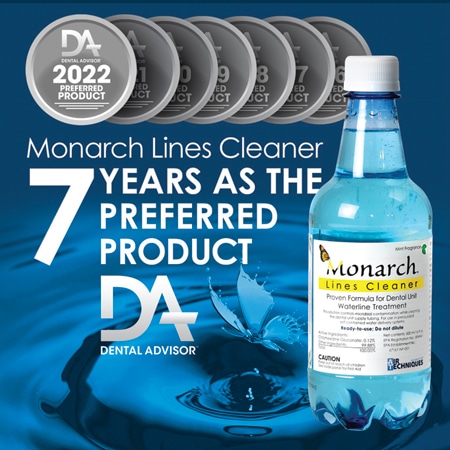Do You Know Your Lines?
Monarch Lines Cleaner by Air Techniques helps oral health professionals ensure the safety of their dental unit waterlines.
Anyone who has acted in a school play understands the work involved in remembering their lines. The time and dedication required to memorize dialogue is similar to that needed to learn all of the nuances of infection prevention and control in dentistry. Even though oral health professionals may not have to memorize dialogue, they need to learn their lines.
 Dental unit waterlines (DUWL) are a network of tubing that transports water from a source to the patient for dental care. Bacterial growth, or biofilm, can occur in the DUWL because the tubing is long with a narrow bore diameter, flow rates may be inconsistent, and oral fluids may be retracted during patient care. The biofilm may develop a protective polysaccharide slime layer that can eventually break off to become free-floating. The planktonic organisms can begin a new biofilm colony at another location in the DUWL, enter the patient’s mouth, or become part of the aerosols produced during patient care, posing significant health risks.
Dental unit waterlines (DUWL) are a network of tubing that transports water from a source to the patient for dental care. Bacterial growth, or biofilm, can occur in the DUWL because the tubing is long with a narrow bore diameter, flow rates may be inconsistent, and oral fluids may be retracted during patient care. The biofilm may develop a protective polysaccharide slime layer that can eventually break off to become free-floating. The planktonic organisms can begin a new biofilm colony at another location in the DUWL, enter the patient’s mouth, or become part of the aerosols produced during patient care, posing significant health risks.
The Environmental Protection Agency (EPA), American Public Health Association, and American Water Works Association have determined that ≥ 500 CFU/mL of heterotrophic bacteria is safe drinking water. The United States Centers for Disease Control and Prevention (CDC) states that “the number of bacteria in water used as a coolant/irrigant for nonsurgical dental procedures should be as low as reasonably achievable and, at a minimum, ≥ 500 CFU/mL of water.”1 Microbial counts in DUWL can exceed 200,000 CFU/mL of water within 5 days after installation of a new DUWL. Treating DUWL to achieve quality water output can be done periodically or continuously. Chemical products remove, inactivate, or prevent biofilm formation in DUWL. It may be necessary to remove already-present biofilm with a shock treatment before starting a new system, when microbial counts start to rise, or when microbial counts exceed the 500 CFU/mL maximum count. Treatment products and devices for DUWL management are regulated by the Food and Drug Administration or EPA.
 Continuous treatments, such as cartridges, straws, or tablets/drops, add an antimicrobial agent to the water either by adding a product directly or automatically as the water passes through a mechanism. The antimicrobial makes the water the means of treatment for the DUWL. The treated water prevents the growth of microorganisms in the line. Periodic treatments are achieved by adding an antimicrobial agent to the waterlines periodically, and then rinsing it out of the lines before patient care. The benefit of periodic treatments is the ability to use water without any added agents for patient care. The best disinfection products and procedures should be EPA/FDA approved, economical, and safe for dental equipment, patients, and clinicians.
Continuous treatments, such as cartridges, straws, or tablets/drops, add an antimicrobial agent to the water either by adding a product directly or automatically as the water passes through a mechanism. The antimicrobial makes the water the means of treatment for the DUWL. The treated water prevents the growth of microorganisms in the line. Periodic treatments are achieved by adding an antimicrobial agent to the waterlines periodically, and then rinsing it out of the lines before patient care. The benefit of periodic treatments is the ability to use water without any added agents for patient care. The best disinfection products and procedures should be EPA/FDA approved, economical, and safe for dental equipment, patients, and clinicians.
Monarch Lines Cleaner by Air Techniques is a seven-time award-winning weekly DUWL treatment. It can also be used as a shock treatment if testing shows an increase in microbial counts. With its safe and effective chlorhexidine and ethanol solution, Monarch Lines Cleaner is simple to use with no need for mixing or dissolving tablets.
According to the CDC, “Water treatment and monitoring products require strict adherence to maintenance protocols, and noncompliance with treatment regimens has been associated with persistence of microbial contamination in treated systems.”1 Therefore, every dental facility should have a written waterline management protocol program in place that includes training of oral health professionals on maintaining DUWL, what constitutes quality water, how biofilm is formed, how to treat the waterlines, and how to evaluate the waterlines with regular testing.
AIR TECHNIQUES
800-AIR TECH
Reference
- Kohn WG, Collins AS, Cleveland JL, et al. Guidelines for infection control in dental health-care settings—2003. MMWR Recomm Rep. 2003;52:1–61.
From Dimensions of Dental Hygiene. June 2022; 20(6)24.

